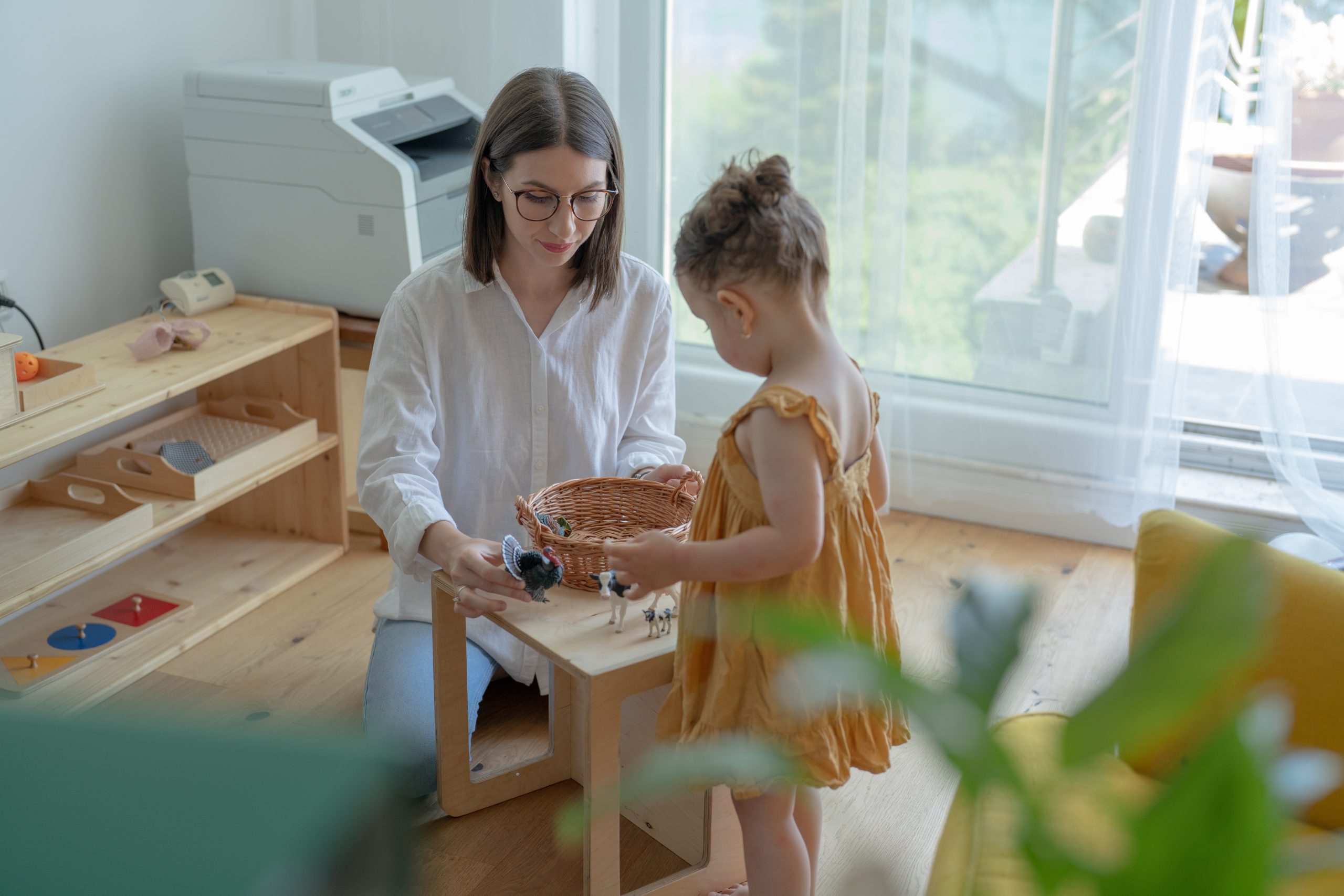Montessori Homeschool Environment
Homeschooling allows you the freedom to step off the highway of learning and take a more scenic route along a dirt road.
This inspiring homeschool quote from writer and homeschooling mom Tamara Chilver highlights two of the potential perks of homeschooling: flexibility and freedom. In a Montessori homeschool setting, this flexibility and freedom often come from the educational environment itself, which Dr. Montessori called “the prepared environment.” In this article, we’ll give five tips to help homeschooling families create an authentic Montessori environment at home:

5 Ways to Create A Montessori Homeschool Environment
1. Prioritize accessibility throughout the space.
Maria Montessori prioritized children’s independence from adults and created opportunities for independence in the learning environment. She found that children  build their autonomy as they can access learning materials without the assistance of an adult. There are many ways to achieve accessibility in the homeschool environment. Some examples include providing child-sized furniture, low shelves, and stools.
build their autonomy as they can access learning materials without the assistance of an adult. There are many ways to achieve accessibility in the homeschool environment. Some examples include providing child-sized furniture, low shelves, and stools.
Accessibility is important because it gives children the freedom to tackle more tasks independently. Sitting on furniture made for their body size can help kids be comfortable and focus on the task at hand. Low shelves with games, blocks, or activity trays can give kids access to the materials they want to engage in when they are motivated. It can mean fewer hands-on responsibilities for adults and more opportunities to sit back and observe their children, another emphasis of the Montessori method.
2. Keep the learning environment organized and clutter-free.
The Montessori environment cultivates a child’s sense of order through organization and minimal clutter. There are fewer items in the environment, and the educators intentionally choose materials to match the child’s skills and interests. Additionally, the available items often have a designated place where they are stored. Montessori argued that a sense of order fosters feelings of comfort and calm in children, which can help them learn.
There are many wonderful educational materials and activities that can fit into a homeschool environment. Well-meaning parents and educators can purchase materials in excess to provide opportunities for learning. But the Montessori philosophy encourages parents to resist this temptation and make fewer items available. Rotating items is one way to provide variety in the learning space while having minimal items out at one time.
Another way to promote order is to regularly evaluate the available materials, purge unnecessary items, and create a designated Montessori workspace for your child.
3. Follow the child.
Famously, Maria Montessori encouraged educators to follow the child. Following the child starts with the Montessori principle of observation, which gives educators a greater understanding of the child so that they can provide activities that suit their interests and development.
Tailoring learning to the child can foster curiosity and a love of learning. The freedom afforded by homeschooling can provide more opportunities to follow children than in the traditional classroom. Parents can start by observing their children and tailoring instruction to best fit them.

One way to tailor instruction in homeschooling is to choose books and activities on topics that interest the child. Outings to an aquarium, zoo, library, or art gallery may also help children cultivate a particular interest or skill. Parents may provide an introduction to the piano to a child who loves music, for instance.
Educators can also take time to identify skills that a child can strengthen and provide opportunities for them to do so. For example, if a child lacks fine motor skills, parents can provide opportunities for the child to use tongs to transfer materials or use their hands to open and close containers.
4. Teach practical skills to build independence, confidence, and autonomy.
 A homeschooling environment can greatly benefit from Montessori practical life activities. Families can create a Montessori homeschool environment by prioritizing the mastery of everyday life skills like washing hands, getting dressed, setting the table, cooking, and gardening. The Montessori By Mom Helping Hands Toolbox includes all the child-sized items families need to help their children participate in practical life activities.
A homeschooling environment can greatly benefit from Montessori practical life activities. Families can create a Montessori homeschool environment by prioritizing the mastery of everyday life skills like washing hands, getting dressed, setting the table, cooking, and gardening. The Montessori By Mom Helping Hands Toolbox includes all the child-sized items families need to help their children participate in practical life activities.
Homeschooling educators can break down these skills into small pieces and teach them slowly over time. Learning to care for themselves and their environment can build independence and confidence in children. Additionally, through learning practical skills, kids can develop a sense of responsibility for their actions.
5. Consider the materials brought into the learning environment through the Montessori lens.
Another way to set up a Montessori homeschool environment is to intentionally choose  materials for the learning space. The Montessori learning environment often includes natural materials, such as wood, shells, stones, and natural fabrics. Including live plants in the workspace is another way to bring nature indoors.
materials for the learning space. The Montessori learning environment often includes natural materials, such as wood, shells, stones, and natural fabrics. Including live plants in the workspace is another way to bring nature indoors.
Additionally, the Montessori framework supports an environment with beautiful items. These items may include artwork, like paintings and sculptures, or handmade materials and furniture. A simple, clean, and orderly environment also contributes to an overall feeling of beauty. An intentional environment can engage children and develop a sense of wonder and interest.
The Power of Small Actions Over Time
Creating a Montessori homeschool environment can be a wonderful way to support a child’s independence, curiosity, and love of learning. While it’s tempting to hop online and purchase many of the beautiful Montessori products available, creating a Montessori learning environment at home is also about function and how a child moves within the space.
Homeschooling families can create a Montessori environment by promoting accessibility and order in their learning space. Additionally, they can tailor learning to the child’s interests and skill level.
Small changes over time can go a long way toward creating a Montessori learning space. For example, the Montessori principle of following the child is not a one-time event but a shift in perspective and priorities over time.
Additionally, parents don’t necessarily need to buy all new furniture in the name of accessibility. Simply storing children’s things in an area low to the ground can promote children’s independence and self-reliance. A low drawer containing children’s dishes and utensils can give them an opportunity to set the table, for example.
Importantly, homeschooling families maintain the freedom and power to use the Montessori principles that help them meet their goals and leave the rest behind. Through a Montessori homeschool environment, families can benefit from both the principles of the prepared environment and the freedom of homeschooling.
What does Montessori mean to you on your homeschooling journey? Share with us in the comments!




0 Comments